DNA-Mediated Assembly of Nanotube Devices
Background
An effective strategy for assembly of devices at the nano scale should provide low-error, parallel, autonomous construction of well-ordered structures. An effort was made in our group to develop a DNA-based, bio-inspired strategy for organizing carbon nanotubes, fullerenes, and other components for nano devices. To the “programmed” assembly scheme we envision, DNA contributes molecular recognition, convenient (de-) hybridisation conditions, and compatibility with existing biotechnological tools, such as gel electrophoresis, enzymatic cutting, and PCR. In this project, the specific goals were to: Chemically modify nanotubes and fullerenes with oligonucleotides, to serve as components for nanodevices:
- Use DNA to encode the assembly instructions for prototype devices;
- Investigate ways to operate on these devices with enzymes and proteins;
- Most fundamentally: explore the interface, at the nano scale, between the biological and inorganic worlds.
Achievements:
As attractive as it may seem to attach DNA directly to nanotubes, this is not easily accomplished. On the one hand, DNA is a water-soluble, rather fragile organic polymer; by contrast, nanotubes are water insoluble and remarkably inert in the harshest chemical environments. The gap between these two chemistries was bridged in our group by the successful derivatization of single-walled carbon nanotubes (SWNT) with PNA (peptide nucleic acid, a DNA mimick). The colorized AFM image above shows a nanotube (purple) attached to DNA via PNA adducts on the nanotube. The derivatization of nanotubes by PNA was published in Nature 420(6917) 761 (2002). For a related general overview see: R. Service, Science 298 2322-3 (2002).
